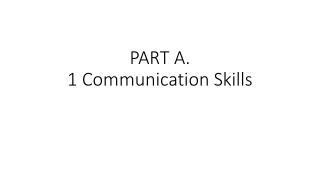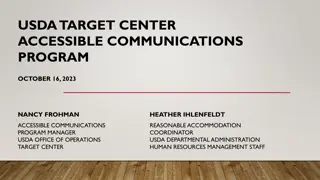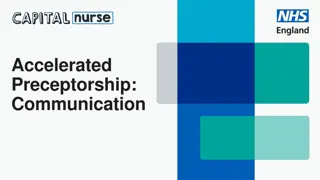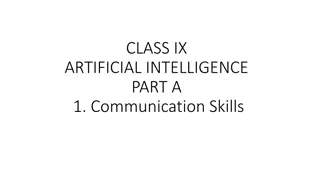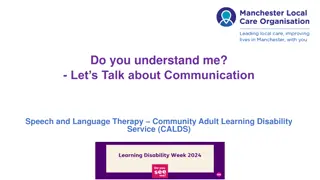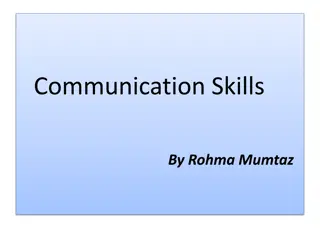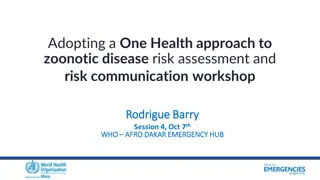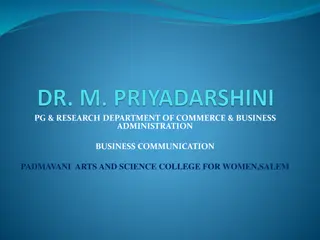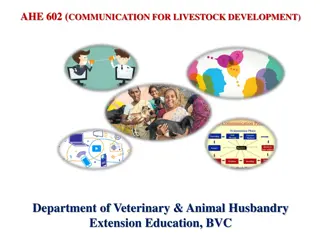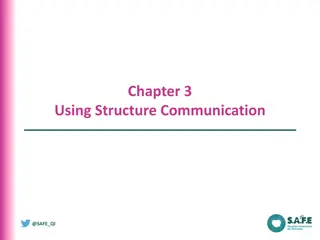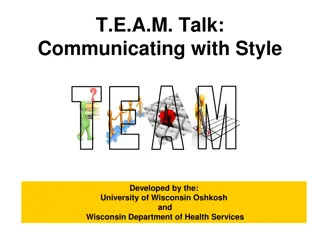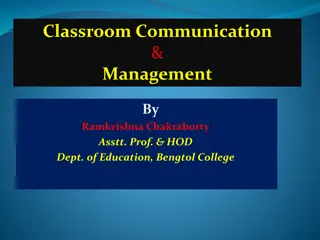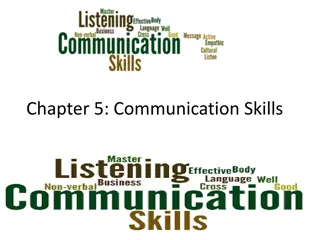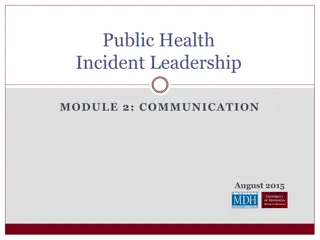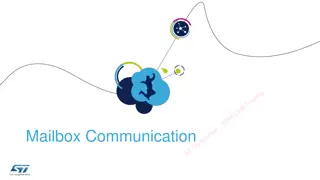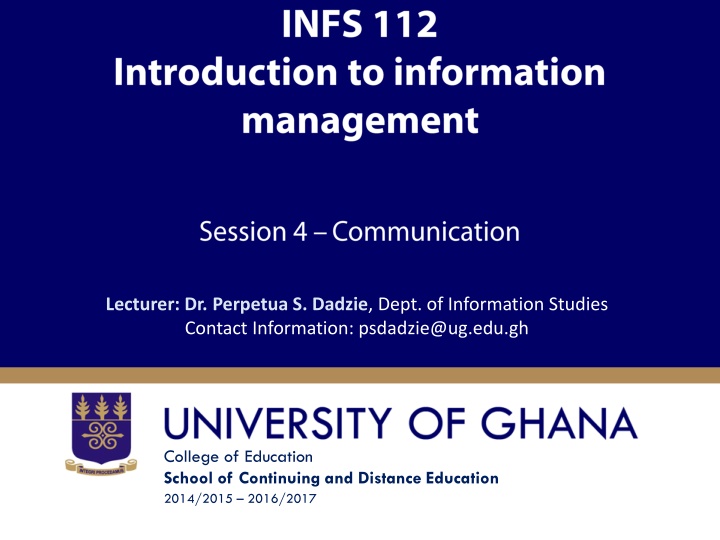
Communication: Importance, Goals, and Processes
Explore the definition, importance, and goals of communication as outlined by Dr. Perpetua S. Dadzie in the session. Discover the key topics covered, such as the 7Cs of Communication and one-way vs. two-way communication processes.
Download Presentation

Please find below an Image/Link to download the presentation.
The content on the website is provided AS IS for your information and personal use only. It may not be sold, licensed, or shared on other websites without obtaining consent from the author. If you encounter any issues during the download, it is possible that the publisher has removed the file from their server.
You are allowed to download the files provided on this website for personal or commercial use, subject to the condition that they are used lawfully. All files are the property of their respective owners.
The content on the website is provided AS IS for your information and personal use only. It may not be sold, licensed, or shared on other websites without obtaining consent from the author.
E N D
Presentation Transcript
Lecturer: Dr. Perpetua S. Dadzie, Dept. of Information Studies Contact Information: psdadzie@ug.edu.gh College of Education School of Continuing and Distance Education 2014/2015 2016/2017
Session Overview At the end of the session, the student will be able to: Define and explain the importance of communication Understand the goals of communication Explain the 7C s of Communication Understand the One-Way and Two-way communication processes Slide 2 Dr. Perpetua Dadzie, Dept of Information Studies
Session Outline The key topics to be covered in the session are as follows: Topic One - Definition and Importance of Communication Topic Two - Goals of Communication Topic Three 7Cs of Communication Topic Four One-way and Two-Way Communication Processes Slide 3 Dr. Perpetua Dadzie, Dept of Information Studies
Reading List Palmer, S. & Weaver, M. (1998). Information Management. Oxford: Butterworth Heinemann. pp.70 Slide 4 Dr. Perpetua Dadzie, Dept of Information Studies
Topic One DEFINITION AND IMPORTANCE OF COMMUNICATION Slide 5 Dr. Perpetua Dadzie, Dept of Information Studies
What is Communication? It is about sending and receiving information or the transmission of information and meaning from one party to another through using shared symbols. It is the process of exchanging information, ideas, thoughts, feelings, emotions through speech, signals, writing, behaviour It involves the interchange of facts, thoughts, value judgments and opinions Dr. Perpetua Dadzie, Dept of Information Studies Slide 6
Importance of Communication Communication used everywhere At work used to provide people with information that they need to make decisions Used to motivate people by explaining what needs to be done, by setting goals and providing feedback In social lives used to build good relationships and create mutual understanding in groups, clubs and societies Dr. Perpetua Dadzie, Dept of Information Studies Slide 7
Topic Two GOALS OF COMMUNICATION Slide 8 Dr. Perpetua Dadzie, Dept of Information Studies
Goals of Communication Four main goals of communication have been identified: To inform To persuade To motivate To build mutual understanding Dr. Perpetua Dadzie, Dept of Information Studies Slide 9
Goals of Communication(2) To inform: without communication, no one would know your achievements, programmes or plans. To persuade: you may want to influence people to take certain actions and the way to do so is to communicate To motivate: you need to communicate to motivate or encourage people to give of their best To build mutual understanding: if someone is talking to you and you understand exactly what is being said then communication has been successful Dr. Perpetua Dadzie, Dept of Information Studies Slide 10
Topic Three 7CS OF COMMUNICATION Slide 11 Dr. Perpetua Dadzie, Dept of Information Studies
7Cs of Communication There are various types of communication, all of which are used in organizations. Whichever type is used, it is important to remember that effective communication must have the following qualities: Correctness Clarity Conciseness Completeness Consideration Concreteness Courtesy Slide 12 Dr. Perpetua Dadzie, Dept of Information Studies
7Cs of Communication (2) Correctness means: Use the right level of language Correct use of grammar, spelling and punctuation Accuracy in stating facts and figures Correctness in message helps in building confidence. Clarity Clarity demands the use of simple language and easy sentence structure in composing the message. When there is clarity in presenting ideas, it s easy for the receiver/decoder to grasp the meaning being conveyed by the sender/encoder. Clarity makes comprehension easier. Slide 13 Dr. Perpetua Dadzie, Dept of Information Studies
7Cs of Communication (3) Conciseness can be achieved by avoiding wordy expressions and repetition. Using brief and to the point sentences, including relevant material makes the message concise. Achieving conciseness does not mean to loose completeness of message. Conciseness saves time. Completeness the message must bear all the necessary information to bring the response you desire. The sender should answer all the questions and with facts and figures. and when desirable, go for extra details. Completeness brings the desired response. Slide 14 Dr. Perpetua Dadzie, Dept of Information Studies
7Cs of Communication (4) Consideration Consideration demands to put oneself in the place of receiver while composing a message. It refers to the use of You attitude, emphases positive pleasant facts, visualizing reader s problems, desires, emotions and his response. Consideration means understanding of human nature. Concreteness Being definite, vivid and specific rather than vague, obscure and general leads to concreteness of the message. Facts and figures being presented in the message should be specif. Concreteness reinforces confidence. Slide 15 Dr. Perpetua Dadzie, Dept of Information Studies
7Cs of Communication (5) Courtesy Courtesy means not only thinking about receiver but also valuing his feelings. Much can be achieved by using polite words and gestures, being appreciative, thoughtful, tactful, and showing respect to the receiver. Courtesy builds goodwill. Slide 16 Dr. Perpetua Dadzie, Dept of Information Studies
Videos Communication Skill (7 Cs of communication) <iframe width="420" height="315" src="https://www.youtube.com/embed/YIS_CeejrMo " frameborder="0" allowfullscreen></iframe> Slide 17 Dr. Perpetua Dadzie, Dept of Information Studies
Topic Four THE ONE-WAY AND TWO-WAY COMMUNICATION PROCESSES Slide 18 Dr. Perpetua Dadzie, Dept of Information Studies
The One-way Communication Process Several ways of communication. Examples: One-way communication, Two-way communications. One-way Communication when a person sends a message to another person and no questions, feedback or interaction follow. Good for giving simple directions Fast but often less accurate than two-way communication Slide 19 Dr. Perpetua Dadzie, Dept of Information Studies
The Two-way Communication Process Two-way Communication A process in which information flows in two- directions the receiver provides feedback and the sender receptive to the feedback. Good for problem solving It is more accurate and fewer mistakes in transmission. it is time-consuming and more difficult for the sender. Slide 20 Dr. Perpetua Dadzie, Dept of Information Studies
Activities Slide 21 Dr. Perpetua Dadzie, Dept of Information Studies
References Seven C s of Effective Communication http://www.managementstudyguide.com/seven-cs- of-effective-communication.htm Slide 22 Dr. Perpetua Dadzie, Dept of Information Studies

